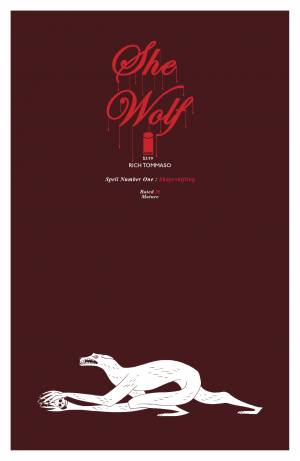Review: She Wolf #1
She Wolf #1 kicks off a series somewhere between Black Hole and Cry Havoc that hasn't quite sunk its teeth in yet. One of my favorite comics last year was Rich Tommaso's Dark Corridor. I wrote about it here and even dove further into detail about some of my favorite pages elsewhere: stylistically, Tommaso was doing a lot of interesting things. I can still vividly remember pieces of a particularly successful chase sequence in one of the issues, for instance. Despite sticking to the very familiar crime noir genre in comics, Tommaso constantly made things feel fresh with his sense of style and willingness to innovate the way which he presented stories.
She Wolf continues Tommaso's emphasis on telling a story with style. I think that his approach to narrative should not be misconstrued as the "style over substance" quip you sometimes hear about works like this that are more concerned with the visuals than they are with a neat (sometimes boring) dialogue-driven plot. She Wolf is an example of a comic that is willing to tell the story with colors and motion rather than the more conventional ways you might expect from a genre comic coming out of Image.
 And that's really the key, I think, to appreciating where She Wolf goes right and where it goes wrong. By using characters and the overall plot as mere touchstones, Tommaso sets his story apart by making the weird things in the world truly weird. Readers will get lost in a brief dream-like sequence and be able to appreciate the oddities of the main character Gabby's encounter with her principal. There is a great deal of space in this story, if that makes sense: room to interpret, room to stretch your legs and fit each page mentally where you would like it. The nonchalance with which the characters in the story treat Gabby's existence as a werewolf raises so many questions, and imbues the world with a great deal of intrigue as the story goes on.
And that's really the key, I think, to appreciating where She Wolf goes right and where it goes wrong. By using characters and the overall plot as mere touchstones, Tommaso sets his story apart by making the weird things in the world truly weird. Readers will get lost in a brief dream-like sequence and be able to appreciate the oddities of the main character Gabby's encounter with her principal. There is a great deal of space in this story, if that makes sense: room to interpret, room to stretch your legs and fit each page mentally where you would like it. The nonchalance with which the characters in the story treat Gabby's existence as a werewolf raises so many questions, and imbues the world with a great deal of intrigue as the story goes on.
I like space in my stories. As much as I like great dialogue writers and plot-drivers like the the Urasawas of the world, sometimes I don't want to turn the goddamn page right away in order to enjoy a comic: sometimes I just want to ponder things and watch a werewolf leap up the stairs in an inky silhouette.
But She Wolf suffers from having too much space. One of the obvious downsides to not relying heavily on plot to drive things is that you don't have plot to drive things. One of the benefits of a more conventional approach with less space in between the pages isn't just that things are easier to follow: it's that things gain a certain momentum. Dark Corridor had a momentum inherent in its genre, and particularly in Tommaso's explication of the "7 Deadly Daughters" storyline. One of the very questions making She Wolf so interesting, however, is what makes it daunting. With only one issue, it's a mystery whether or not there's even really a mystery.
With what readers can see in previews and work in progress on Tommaso's Twitter, a new character is going to enter the series and probably bring things a little more down to earth. I think that's what was missing in this issue. Essentially all the reader is left with is a series of dream sequences, and as a result readers are left up in the air. I suppose that's typical, in some respect, of what a #1 issue often sets out to achieve. The reason this issue will leave readers wanting, though, is that each sequence asks more questions than it answers (sometimes even the same questions) and fails to settle into a more tangible identity by the end.
Ultimately, She Wolf #1 is full of enjoyable sequences that feel like they are quick to go nowhere. Tommaso's broken inks, colorful speech bubbles, and knack for settings comprise a solid, interesting visual identity for this story. The focus on tone, however, ends up feeling monotonous, and ultimately leaves me decidedly undecided on this comic.
[su_box title="Score: 3/5" box_color="#8955ab" radius="6"]
[/su_box]
